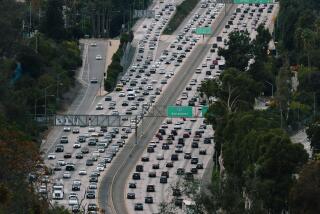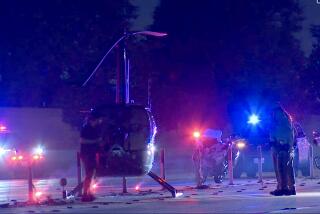And the Moral Is: Assuming Your Commute Will Be Fast Will Jinx You
- Share via
A few weeks ago, I was caught out past my curfew. My 4 p.m. curfew. After 10 years in Los Angeles, I make it a rule never to be more than 10 miles from my Glendale home during rush hour. But there I was, chasing my shadow down Pico Boulevard in Santa Monica, heading for the onramp to the 10 East. I consoled myself with the thought that at least the traffic wouldn’t be as bad for me as for those on the 10 West.
When I lived in the Marina and worked downtown, gridlock was caused by those with similar setups--lived west, worked east. The rotten cherry on the moldy cake of evening commuterdom was watching eastbound motorists whoosh past, blithe as skylarks.
So in theory, I was now entering the whoosh-side of the freeway.
Right.
At first, I blamed the tie-ups on the 405; once we cleared that, the whooshing would begin. Then I pinned my hopes on Robertson, La Cienega, La Brea, even. Finally, I had to admit it--there would be no whooshing for me.
Then I looked at the westbound side. Not exactly whooshing, but they were at least moving, and pretty blithely too. Clearly there had been a shift in the universal order. Someone really ought to send around fliers when these sorts of things happen.
According to Nick Jones, a transportation engineer at the California Department of Transportation, rush-hour patterns on the 10 have been shifting for a while, starting about six years ago with the opening of the 105. It takes about six months to a year for “the dust to settle” after a new traffic corridor is opened, he says; this one may have taken a bit longer because a few months after the 105’s debut, the 10 was cracked by the Northridge earthquake. It stayed closed for about six months, and its traffic patterns haven’t been the same since.
“People keep switching back and forth until they find the ride that’s best for them,” Jones says.
The high-tech boom in Santa Monica and its environs has also contributed to the 10’s new commuting profile. For many years, a large percentage of freeway motorists were those who lived on the Westside and worked elsewhere; now, more non-Westsiders are taking the freeway to Santa Monica and Venice employers.
An even bigger traffic shift is occurring on the western part of the 101, for the same reason, Jones says. The stretch from Moorpark, Camarillo, even Oxnard, once a fairly reasonable drive, is increasingly lit by a thousand brake lights as residents now travel into Ventura County from the Valley in the morning and back again at night.
“It’s like what happened in Orange County years ago,” says Jones. “It used to be all the traffic was from Orange County to downtown. Then the bedroom communities went up. Then the businesses realized they could get land cheaper and their people wouldn’t have to commute. Now there’s just as much traffic from downtown as there is to it.”
For those confronting them day after day, rush-hour patterns seem one of the few inviolable things in a chaotic universe, but they are not, as it turns out, set in stone. Or even concrete. There are seasonal changes--summer is actually the busiest time because of vacationers, but the rush hour is usually lighter. A good economy produces more traffic than a bad one; when you’re not worried about your job, you do more driving, to restaurants, movies and all the classes and clubs for which you can now sign up your child.
The first day of school creates its own flurry of increased volume. Events--concerts, baseball games--can keep the alert driver revising evening routes, and, of course, there are the endless construction projects that can force thousands of motorists to find alternate routes for months at a time.
And humming beneath all these changes is the official, and constant, conversation of Los Angeles--what route did you take? Amateur cartographers all, we Angelenos are ever revising our personal maps of the area, seeking the Holy Grail of driving--the 20-minute commute.
Like water, Jones says, traffic seeks its own level--if the evening commute on the westbound 10 seems light now, just wait a few months. Word will travel, from one driver to another, and then things will shift again.
*
Mary McNamara can be reached at [email protected].
More to Read
Sign up for Essential California
The most important California stories and recommendations in your inbox every morning.
You may occasionally receive promotional content from the Los Angeles Times.











